






Thanks to globalization and the emergence of technologies, international boundaries have become blurred. English, to a high degree, is a commonly understood medium of communication. It is one of the key tools that students need to perform well today and in the future. According to a global study, while recruiting, 98.5% of employers implicitly or explicitly assess a candidate’s English communication skills! There is therefore a growing demand for English communication skills, because it empowers people and enables them to lead a better life.
Functional communication skills, involving aspects of LSRW (listening, speaking, reading and writing), are central to knowledge acquisition, children’s intellectual, social and emotional growth, and life-long learning.
Specifically, strong listening and speaking skills are not only vital in the overall language learning process, but also lead to better reading and writing skills. Yet, these foundational skills tend to be neglected in schools due to the high pupil-teacher ratio, lack of oral language-focused assessment, and most importantly, a lack of systematic and allocated practice time for these skills within the classroom.
Aligned with NEP 2020, NCERT learning outcomes and standardized to CEFR (Common European Framework for Reference) levels, Uolo Speak is a hybrid learning program that focuses on building, applying, practising, and assessing these core language skills.
First, through this book as one of the components of the program, the English classroom becomes an avenue to hone functional speaking skills in real time. The teacher-led activities give learners the opportunity to undertake high-quality, level-appropriate, and experiential activities that help to build confidence and expression in English.
Second, the mobile interface of the product ensures consistent practice of functional LSRW skills. These exercises go beyond traditional question types and employ cutting-edge technology to enable learning and generate instant feedback. For instance, learners practise speaking with Al (artificial intelligence), as if conversing with a real person!
Third, Uolo Speak assessment can be conducted by the school in sync with their academic calendars. The assessment is evaluated by Uolo’s English specialists to give performance report and feedback.
Finally, the reporting methodology used in the above three program components, generates a skill growth chart against CEFR levels for each learner, class and the school. Educators can then clearly identify learners who are reaching, meeting, and exceeding the level requirements, and support them accordingly.
Uolo Speak is a powerful, exciting, and unique experience for learners and teachers. It represents a real life and results-oriented approach to develop essential 21st century functional English skills.
Wishing all teachers, parents, and learners lots of fun and joyful experiences as you embark upon this exciting journey with Uolo Speak.

I am a veteran English teacher and lecturer, with a great love for English and for teaching. I have taught English and trained teachers over many years. I live in South Africa and it is a wonderful experience working with a company promoting the learning of English in India.
Each chapter is divided into three sections - Part A, E-Speak, Part B.

Part A should be completed in period 1, which includes reading aloud of a text and one listening-speaking activity to practise the competency targeted in the chapter.


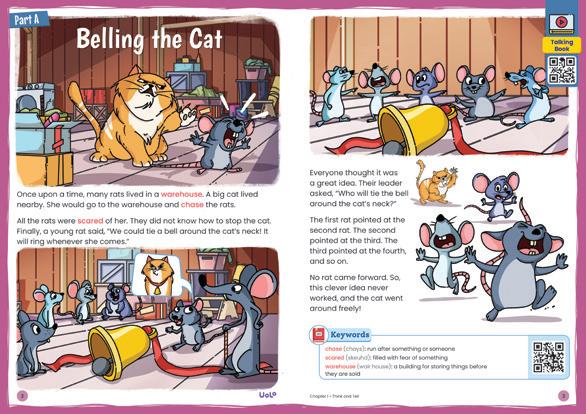
A text to be read aloud and discussed in period 1
E-Speak comprises two digital activities aligned with target competency, which can be accessed through the given QR codes. These activities can be done at home or in school.


Part B focuses on learners’ presentations, which is prescribed to happen in period 2 after adequate practice of the chapter competency. It begins with a small warm up activity.
Tells the chapter number andchapter title, along with animage to convey the mainidea of the chapter
Scan the QR code to watch the animation of the text on mobile app
Scan the QR code to listen to the pronunciation of difficult words from text
One listening speaking activity for practice in period 1
Prompts for learners to help them think before speaking Quick tips for learnersto help them maketheir interestingpresentations
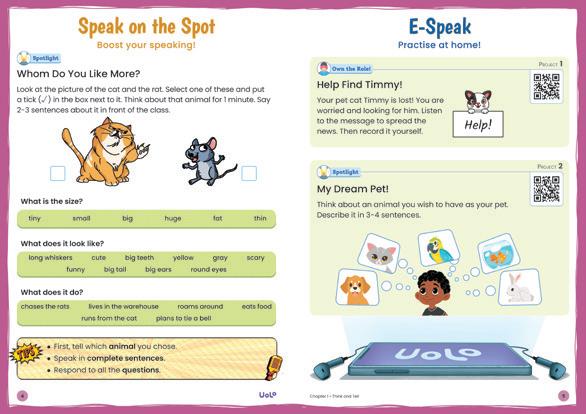

To get learners warmed up at the beginning of period 2
Digital section of the book, which features QR codes for two mobile app activities

Learners work individually
Learners work in pairs
Learners work in groups of three/four/five
Teacher does the activity along with the whole class
Solo/pair/group presentations by learners, tied to the theme and competency of the chapter, in period 2
Graphic organisers forlearners to plan forthe presentation andwrite notes beforespeaking
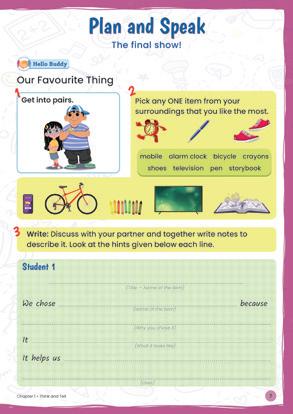
Space for learnersto reflect on peers’presentations andwrite their thoughts
3
Listen to descriptions in order to identify key details
Describe a person/ place/ animal/ thing with fluency, confidence and expressions
4
short rhyming
5
6
7
8
Narrating
- verbally and
to
Create short rhyming lines Sing rhyming lines with fluency, rhythm and expressions
Ask questions starting with what, where, why, when and how Respond to questions
Listen to and interpret key details in informational texts
Speak persuasively about advantages or disadvantages of something
Appreciate a narrative experience while listening to it Narrate travel experiences in detail with appropriate vocal and facial expressions
Capture important details and ideas by listening to news reports
Report important events accurately and clearly
In order to ensure the participation of the maximum number of learners during the classroom presentations and to keep the surprise element going, you can try the following quick games for inviting learners to participate:
• Pick the name chits from a bowl.
• Call out the roll number in a random fashion.
• Say some unique identification markers, e.g. the one who is carrying a blue water bottle, the one whose name starts with A, the one whose name ends with P, the one who has a red bag.
• Throw a ball and give an opportunity to the one who catches it.
• Sing a song/recite a poem while students swiftly pass an object on to each other. The one who is holding it when the song/poem ends, has to present.
• After their presentation, each student invites the next presenter.
• Open a book randomly at a page. Call out that (roll) number for presentation.
Chapter 1 Chapter 2 Chapter 3 Speak on the Spot
Plan and Speak
Speak on the Spot
Plan and Speak
Speak on the Spot
Plan and Speak
Chapter 4 Chapter 5 Chapter 6 Chapter 7 Chapter 8 Chapter 9 Speak on the Spot
Plan and Speak
Speak on the Spot
Plan and Speak
Speak on the Spot
Plan and Speak
Speak on the Spot
Plan and Speak
Speak on the Spot
Plan and Speak
Speak on the Spot
Plan and Speak
About the Chapter: Through this chapter, learners will develop the skill of describing something.
Listening Speaking Competencies: Learners will be able to
• listen to descriptions in order to identify key details.
• describe a person/place/animal/thing with fluency, confidence and expression.
• Read aloud the story OR play the Talking Book in the class.
10 min
• Ask questions as follows. Invite responses from as many learners as possible.
Before story: Why are rats scared of cats?
During Story: After “Who will tie the bell around the cat’s neck?": Do you think anyone will come forward to tie a bell around the cat’s neck? Why?
After story: What do you think the cat feels like now?
Speak on the Spot!
• Instruct:
20 min
A. Think about who do you like more - the cat or the rat! Put a tick (√) against it.
B. Think about that animal. Refer to the 3 questionsWhat is the size? How does it look? What does it do?
C. Use the prompts to get ideas.
D. Give an example: I like the cat. It is very fat and scary. It has a big tail. It runs after the rats.
• Allot 1-2 minutes to think.
• Say: Now I will call some of you to tell us about the animal you like. Take care of the following things:
A. First, say which animal you like.
B. Speak in complete sentences as you answer the 3 questions.
C. Speak in a flow.
• Invite AS MANY learners to present. Select randomly through games. (page vii)

• Sample: Hello! I like the rat. He is very small. His eyes are big and round. His ears are also very big. The rat looks very funny. He lives in the warehouse Thank you.

Very good! You described the rat very well. Just take care to speak a bit more loudly.
Instruct the learners to complete both the projects in the E-Speak section.
This project will be automatically evaluated. Scan the QR code to see the submissions of your learners.
This project will be evaluated by you. Scan the QR code to see the submissions of your learners.
Explain steps 1-4 in the Plan and Speak section for prep-work. Facilitate as follows.
1. Divide the class into pairs.
2. Instruct the pairs to pick any one item from their surroundings that they like the most. Guide them to use the prompts for ideas, if needed.
3. Instruct learners to discuss in pairs and write notes to describe that item. Guide them to look at the hints given below each line.
4. Suggest them to take one part each in the pair and practice speaking their lines.

time
the path

burrow.
give it the flavour of a fun competition!
drew. Appreciate them.
water bottle
saying your parts.
through games. (page vii)


min

• Appreciate all presentations. Give concrete feedback on content, fluency, presentation style and team work.
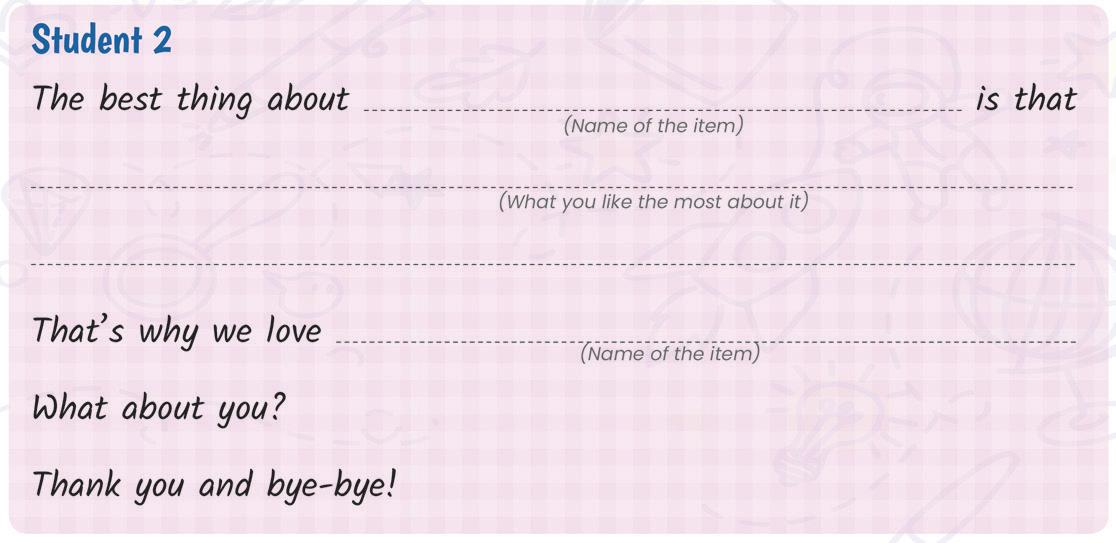
“Thank you. I really appreciate how nicely you described the uses of a water bottle. You spoke clearly. But next time, make sure that both members in the pair speak. Also, don’t be scared. We are all your friends here.”

a water bottle we can take it anywhere. It never lets us be thirsty! a water bottle.




About the Chapter: Through this chapter, learners will develop the skill of asking questions and responding to them.
Listening Speaking Competencies: Students will be able to:
• Ask questions starting with what, where, why, when and how.
• Respond to questions.
• Read the story aloud OR play the Talking Book in the classroom.
10 min
• Ask questions as follows. Invite responses from as many learners as possible.
Before story: Read the title. Ask: Do you know what a shepherd is?
During Story: After “How many drops of water are there in the sea?”: What do you think is the answer? Can we count the drops of water in the sea? Why?
After “How many stars are there in the sky?”: Can we count the total number of stars in the sky? What do you think the boy must have answered?
After story: Do you think the little shepherd boy was clever? Why?
Bingo!
• Invite a volunteer and demonstrate the activity.
• Instruct:
20 min
A. Think of any one thing that is in your bag. I’m going to ask you some questions to find out what it is.
B. Ask: What is its shape? What it is made of? How it is used?

C. Say ‘Bingo’ aloud when you can identify the object.
• Do the activity once or twice until all learners understand.
• Explain: Similarly, I will think of an item. Now, you need to ask me questions to find out what it could be. You can ask what it looks like, what it is made of, what it is used for and so on. You need to say ‘Bingo!’ aloud as soon as you identify the object.
• Instruct: Keep count of how many objects you identified correctly. Keep writing in the book.
• Conduct this activity for at least 10-15 commonly found items. For example: chalk, water bottle, cap, soap, pencil, fan, shoes, etc.

Instruct the learners to complete both projects in the E-Speak section.

This project will be evaluated automatically. Scan the QR code to see the submissions of your learners.
This project will be evaluated by you. Scan the QR code to see the submissions of your learners.
Explain steps 1-3 in the Plan and Speak section for prep-work. Facilitate as follows.
1. Divide the class into groups of four.
2. Instruct groups to discuss and complete the interview script. Brief them on what an interview is. Guide them to use the prompts for ideas if needed.
3. Finally, suggest to groups that they divide the 4 roles among themselves and practise enacting the interview accordingly.
min
• Instruct learners to spot the greatest number of differences between the pictures.
• Allocate 1 minute to give it a fun-game twist.

• Instruct them to tick the ranks below for the number of differences they found.
Blockbuster
•
A.

the activity for the learners.
B. Instruct: Revise the interview script. Practise saying your parts.
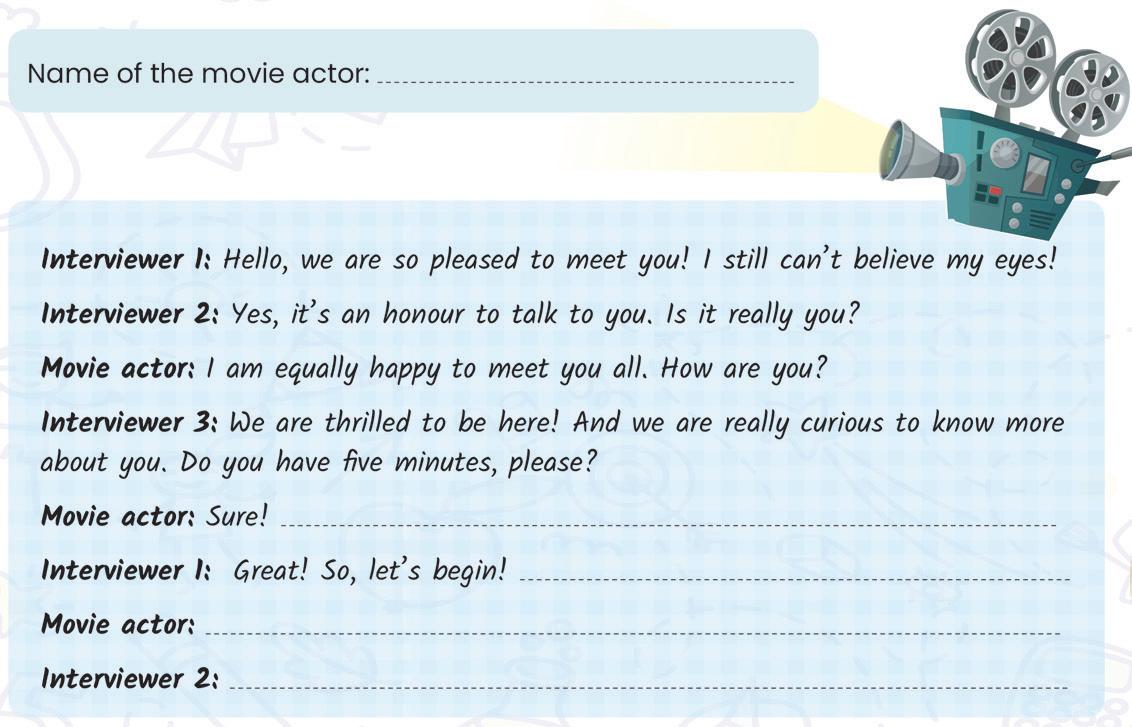
•
5 min
30 min
• Invite ALL groups for the presentation. Select randomly through games. (pagevii)
• Instruct: Step forward in groups, and enact your interviews. Play your parts with

expression and body language.
•
Ranjan Kumar
What is your favourite food?
I love eating Noodles as well as Dosai. spending time with us. we are glad to meet you. meet you all.
I like to read and listen to music. Sure! Let’s huddle.
• Appreciate all presentations. Give concrete feedback on content, fluency, presentation style and team work.

“Thank you, team! Your interview was so thrilling. I loved the questions and answers you created. And you all acted so well!
I have one feedback: Look at the person you are interviewing while asking the question.

About the Chapter: Through this module, learners will develop the skill of persuasive speaking.

Listening Speaking Competencies: Learners will be able to
• Listen to and interpret key details in informational texts.
• Speak persuasively about the advantages or disadvantages of something.
• Read the text aloud OR play the Talking Book in the classroom.
10 min
• Ask questions as follows. Invite responses from as many learners as possible.
Before story: What is one gadget that you would like to have? Why?
During Story: After ‘many types of smartphones available in the shops and online, they all have the same basic features.’: What features of smartphones do you know about?
After story: What one feature of smartphones do you think is the most important? What is one caution you need to keep in mind when using a smartphone?
• Divide the class into pairs.
• Instruct:
20 min
A. One of you speaks in favour of smartphones, while the other speaks against them. Write your names in the blanks accordingly.
B. Read the conversation prompts and practise your conversation.
• Allot 2–3 minutes to discuss and practise.
• Say: Now I will call some of the pairs to present their conversations. Take note of the following things:
A. First, tell us which partner is speaking in favour and which one is speaking against the use of smartphones.
B. Speak in complete sentences as you present your conversation.
C. Speak in the same sequence as given for the conversation.
• Invite AS MANY pairs to present as possible. Select randomly through games. (pagevii)

they help us connect to the people we love and need.
We spend too much time watching and creating videos. This can waste our study time. Many smartphone applications help with our homework and learning new things.
The use of many applications needs the internet and cost us.
Good work! Your conversation was very informative! I liked that you shared new pros and cons. I have one feedback –Don’t forget to use expression while talking or presenting. If you struggle to find a word in English, you can ask for help.

Instruct the learners to complete both projects in the E-Speak section.
This project will be evaluated automatically. Scan the QR code to see the submissions of your learners.
This project will be evaluated by you. Scan the QR code to see the submissions of your learners.


Explain steps 1–4 in the Plan and Speak section for prep work. Facilitate as follows.
1. Divide the class into pairs.
2. Instruct the pairs to pick any one pair of items from the given list of topics.
3. Instruct learners to discuss in pairs and fill in the notes for both the products. Suggest that they look at the hints and write about their advantages and disadvantages, following the format.
4. Post writing, suggest that they take one part (product) each and practise speaking in favour of their product. Together, they should practise it as a debate.
5 min
• Instruct learners to label the sentences according to their thinking.
• Invite a few learners to share their responses and reasons for it.
Plan and Speak East or West, My Product is the Best!
• Warm Up 5 min
A. Recapitulate the activity for the learners.
B. Instruct: Revise your notes. Practise how you will present the debate.
• Presentation and Feedback 30 min
• Invite ALL the pairs for presentation. Select randomly through games. (page vii)

it is easy to carry them. They are light in weight. We can use them for watching movies and reading articles. a desktop it is heavy and stays in one place. I support laptops.
Laptops

Desktops they can have a wide screen. We can adjust the height of the screen as well. So, they help us maintain good posture. a laptop they come in small screen sizes. you should buy only a desktop.
• Appreciate all presentations. Give concrete feedback on content, fluency, presentation style and teamwork.
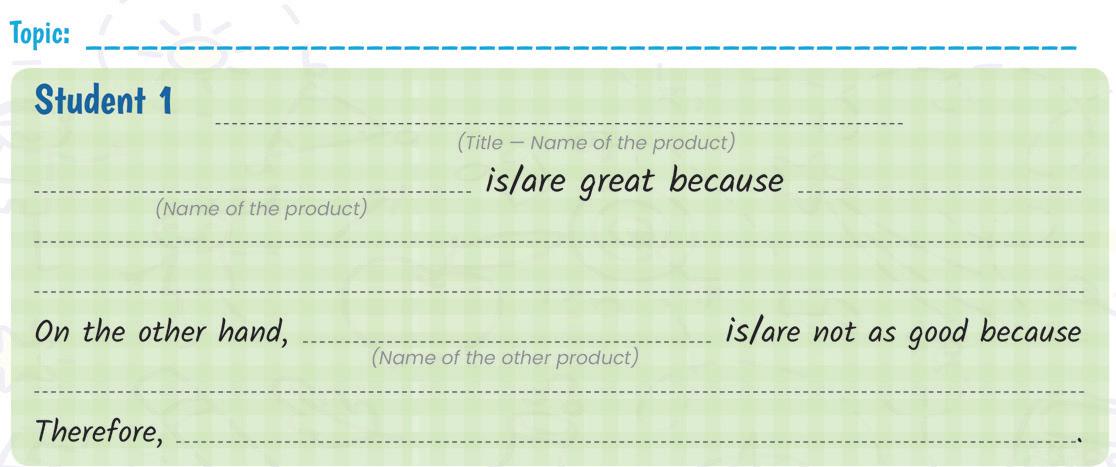
Thank you! You were right about the benefits of your products. I loved how strongly you debated them! Next time, you should make sure that you put your strong points with more confidence.

About the Chapter: Through this chapter, learners will develop the skill of narrating personal experiences around travel – verbally and digitally.

Listening Speaking Competencies: Students will be able to
• Appreciate a narrative experience while listening to it.
• Narrate travel experiences in detail with appropriate vocal and facial expressions.
• Read the story aloud OR play the Talking Book in the class.
10 min
• Ask questions as follows. Invite responses from as many learners as possible.
Before Story: Point at the cover image. Ask: What travel destination do you think this is?
Is it in India or abroad?
During Story: After “Then, suddenly, I caught a glimpse of this pyramid-shaped structure, standing majestically tall with a snow-capped peak!": What do you think this structure is? What other things and activities could Karthik see on the cable-car ride to the top of the mountain?
After Story: If you met Karthik, what would you ask him about Zermatt?
Speak on the Spot!
• Divide the class into pairs.

• Instruct:
A. Think about and decide on a place for your trip.
20 min
B. Refer to the 4 questions in the Travel Planner and discuss themWhere do we want to go? How and when do we want to go? What will we take with us? What will we do there?
C. Use the prompts to get ideas.
D. Give an example: We would like to go to a beach in Goa. We will go there by aeroplane. We will take a camera, some clothes and our ID cards. We will go sightseeing and taste some local food there.
• Allot 2-3 minutes to discuss.
• Say: Now I will call some of you to tell us about your travel plans. Take note of the following things:
A. First, tell us the name of the place where both of you would like to go.
B. Speak in complete sentences as you answer the 4 questions.
C. Speak fluently.
• Invite AS MANY pairs to present as possible. Select randomly through games. (pagevii)
•
Sample:

Hello! We would like to go to Kanyakumari. It has beaches. We will be going there by train during the next winter break. We will take some new clothes, sunglasses & sunscreen, a camera, a backpack, and a cap with us. We will spend an entire day at the beach, drink lots of coconut water and eat seafood, and go to Indira Point by ferry.
Great work! Your travel destination is beautiful and exciting! Just one feedback though – Decide beforehand which member will present what, so that there is no confusion while presenting.
Instruct the learners to complete both projects in the E-Speak section.
Project 1: Reminiscing about Those Hills!
This project will be evaluated automatically. Scan the QR code to see your learners’ submissions.
This project will be evaluated by you. Scan the QR code to see your learners’ submissions.
Explain steps 1-3 in the Plan and Speak section for prep-work. Facilitate as follows.
1. Instruct learners to think of a place where they have travelled recently.
2. Instruct learners to make notes on their travel experiences in the journal. Guide them to use the help words for ideas if needed. Explain different parts of the journal and give some examples.
3. Suggest they practise speaking their lines.



We saw a local festival. We were interviewed by a local TV channel.
Don’t miss the light-sound show in the evening!
• Appreciate all presentations. Give concrete feedback on content, fluency and presentation.
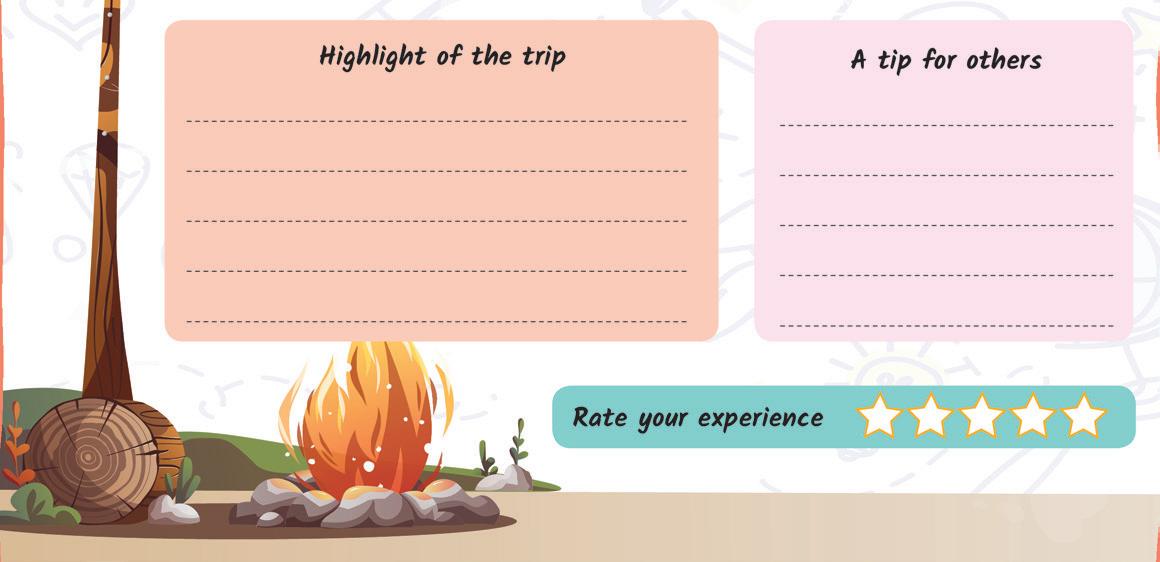
Thank you. I really appreciate how nicely you described your travel experience. It was very detailed. Your voice needs to be louder and clearer though.

Listening Speaking Competencies: Students will be able to:
• Capture important details and ideas by listening to news reports.

• Report important events accurately and clearly.
• Read the story aloud OR play the Talking Book in the classroom.
10 min
• Ask questions as follows. Invite responses from as many learners as possible.
Before Story: Ask: How do you watch matches like cricket and badminton most often? Have you ever seen a live match?
During Story: After “Oh, dear! What will happen now?” Sana said worriedly.: What do you think will happen next? Do you think a sports person can win a match even with an injury? Can you give any examples of such a win?
After Story: Have you ever listened to sports commentaries? Can you tell how they do it?
Speak on the Spot!
• Say: Let’s imagine you are a news reporter for a sports event in your locality.
20 min
• Instruct: Choose any one event from the given images. Report about it as follows: First introduce yourself as a reporter and the event you are covering. Then, tell the time, date and place. Finally, tell 1–2 highlights of the sporting event.
• Give an example: Hi! This is Mehul reporting for the Free Race event from Aadarsh Colony in Gandhi Nagar, Gujarat. It is 10 a.m. on Sunday, 9 October. Twelve participants took part in the 100-meter race. To everyone’s surprise, the youngest participant Mehek, who is only 6 years old, won the race! A big round of applause for her! She received the prize from the RWA President.
• Allot 2–3 minutes to prepare for the presentation.
• Invite AS MANY learners as possible to present. Select randomly through games. (page vii)
• Sample: Hello! I’m Anjana covering the Yoga Challenge from Sector 8, R.K.Puram, New Delhi. Seventeen participants took part in the yoga challenge. The challenge was to hold the Chakrasana pose for 2 minutes. It requires a lot of back flexibility and arm strength. The participants dropping from the pose were eliminated. Only 2 participants were able to stay in the game to the end - 43-year-old Ms Madhuri and her 11-year-old son, Aakash. The umpire declared a tie between them!

About the Chapter: Through this chapter, learners will develop the skill of reporting important events around them.
and give concrete feedback:
Wow! The coverage of the yoga challenge was quite interesting. The highlights you shared were so real and exciting as if we were there watching the match. I have only one feedback for you –You need to modulate your voice a lot more while reporting, so that people want to listen.

Instruct the learners to complete both projects in the E-Speak section.
This project will be evaluated automatically. Scan the QR code to see the submissions of your learners.
This project will be evaluated by you. Scan the QR code to see the submissions of your learners.
Explain steps 1-3 in the Plan and Speak section for prep work. Facilitate as follows.
1. Instruct learners to choose any one event for their report.
2. Guide them to write a draft of the report in the given format. Explain different parts of the format.
3. Instruct learners to watch TV news to get some hints on how to present as a news reporter. Suggest they practice reading out their reports with adequate modulation.
• Instruct: Look at the pictures. Think of interesting captions for them.
• Invite a few learners to share their captions.
5 min
• Warm Up 5 min
A. Recapitulate the activity for the learners.
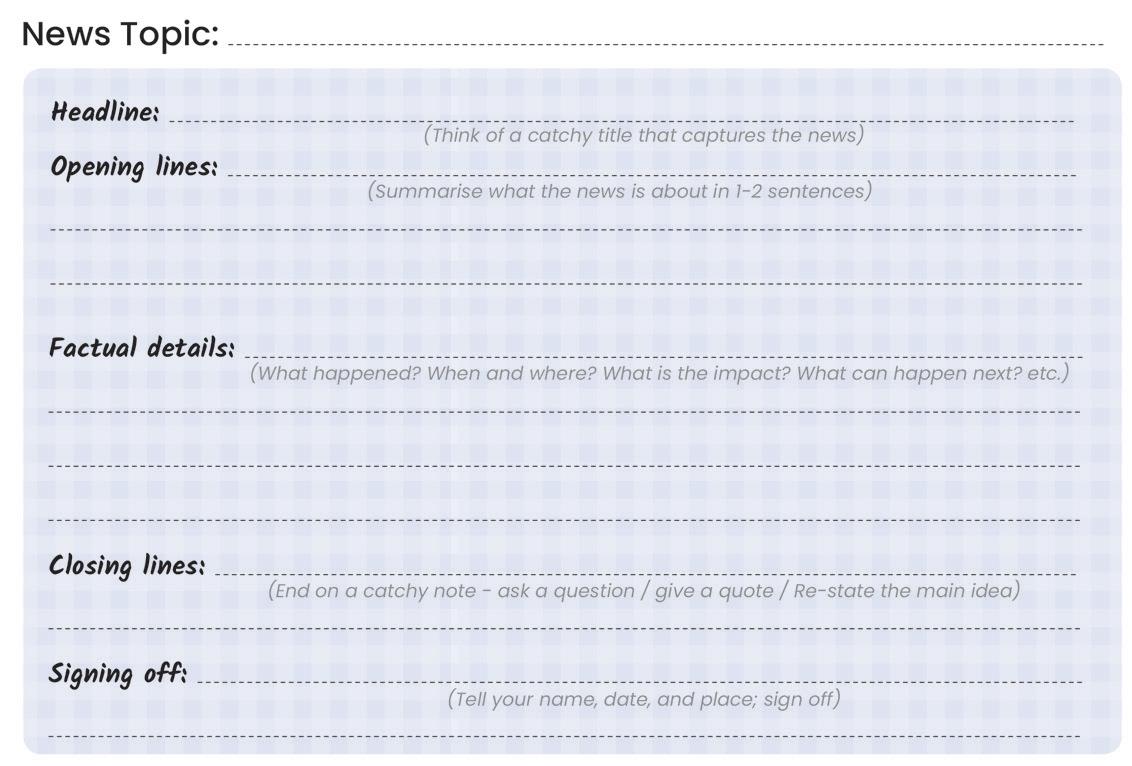
B. Instruct: Revise your reports. Do a quick practice of presenting your report.

• Presentation and Feedback 30 min
• Invite ALL the learners for presentation. Select randomly through games. (page vii)


• Sample:
We could not present this news last night, because like you, we too were in the middle of a mega blackout. Hello and welcome! This morning, we are reporting live from the site where last night’s blackout started. failure in the power grid that supplies about 80% of the electricity. The officials have ordered a shutdown of many facilities - private offices, restaurants and banks due to the power shortage. anytime soon?
Last evening, most parts of our city faced one of the history’s biggest blackout due to a system
What are your thoughts on the condition of power shortage in our city? Do you think it will improve
This is Hardeep, signing off from Chandigarh, Punjab! Thank you for being with me today!
•

Appreciate all presentations. Give concrete feedback on content, fluency and presentation style.
Great work, Hardeep! You covered all the important details, and your report was quite amazing. You really did sound like a professional reporter! Next time, you could hold your geometry box as a mike. It will make it even more interesting.
This “Conversations” book follows a unique spiraling approach that systematically builds language skills and enables children to express themselves verbally in real-world situations, thus preparing them for the needs of the 21st century world. Each chapter focuses on building specific and age-appropriate English language competencies and weaves together activities that are contextual, experiential, joyful and research-based.
• Activities based Learning: joyful and experiential activities that build English communication competencies.
• Texts as per NEP 2020 themes: exciting and stimulating texts that pave the way for English communication activities.
• Tech Integration: the book works in sync with the digital world, where various other activities and projects are undertaken. Learner outputs are evaluated through an AI-based speech recognition engine.
• Assessment of Speaking & Listening as per CEFR: the program includes special assessments that allow systematic reporting of skill growth as per the CEFR.
• Teachers’ Manual: the book is complemented by the Teachers’ Manual that enables teachers to conduct each session effectively.
Uolo partners with K12 schools to provide technology-based learning programs. We believe pedagogy and technology must come together to deliver scalable learning experiences that generate measurable outcomes. Uolo is trusted by over 8,000 schools with more than 3 million learners across India, South East Asia, and the Middle East.

